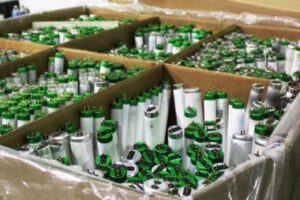Choose TL tube recycling!
We are specialized in the collection and recycling of fluorescent tubes. Contact us or request a sharp quote directly.
Recycling of fluorescent tubes is essential because of the harmful substances they contain and the valuable materials that can be reused. Fluorescent tubes contain, among other things, mercury, a hazardous substance that is harmful to the environment and public health if disposed of incorrectly.
By recycling fluorescent tubes, you not only prevent environmental damage, but you also contribute to the conservation of raw materials such as glass, aluminium and phosphorus. Correct Fluorescent lamps disposal is not only an environmentally friendly choice, but also a crucial step towards a circular economy.

It is important to recycle fluorescent tubes because they contain mercury, among other things. This is a very toxic metal that is harmful to humans, animals and the environment. Throw away fluorescent tubes in the residual waste ensures that these hazardous substances end up in the air, soil or groundwater, which leads to serious environmental damage. In addition, a fluorescent tube contains valuable materials such as glass, aluminium and phosphorus, which are very suitable for reuse.
By recycling fluorescent tubes, you prevent hazardous substances from being released and you contribute to the conservation of raw materials. This is not only a sustainable choice, but also a legal obligation for companies and individuals.
How does fluorescent tube recycling work? The process begins with the collection of old tubes at approved collection points. The tubes are then taken to a recycling facility where they are processed in a safe manner. The recycling process consists of the following steps:
Sorting and preparing
The fluorescent tubes are sorted and prepared for further processing. Broken and intact tubes are treated separately.
Separation of materials
The tube is carefully broken in a sealed system to prevent mercury vapors from escaping. The glass, aluminum, and phosphor powder are separated from each other.
Mercury Removal
The phosphor powder, which contains small amounts of mercury, is treated in a distillation process where the mercury is collected. This mercury can then be reused in industrial applications.
Recycling materials
This recycling process ensures that more than 90% of the materials from a fluorescent tube are reused, contributing to a more sustainable economy.
Yes, a TL lamp is classified as chemical waste due to the presence of mercury and phosphorus. Mercury is classified as 'heavy metals' and is harmful to health and the environment. In addition, phosphorus powder also carries chemical risks.
Because of these risks, it is mandatory to hand in fluorescent lamps at approved collection points for chemical waste. This ensures that they are processed and recycled safely.
An average 100cm to 120cm fluorescent lamp contains approximately 2 to 5 milligrams of mercury. Although this may seem like a small amount, even a tiny amount of mercury can be harmful to the eyes, respiratory tract and skin.
In recycling, this mercury is safely disposed of and often reused in industrial processes. Accurate collection and recycling of fluorescent tubes is therefore of great importance to prevent mercury pollution.
The main harmful substances in a fluorescent tube are:
Mercury
Phosphorus powder
Lead
Other metals and chemical compounds
As a private individual, you can hand in old TL tubes at recycling centers, DIY stores, or supermarkets that have collection points for small chemical waste. Companies can have their TL tubes collected by specialized collection companies or return them to suppliers.
It is important not to throw fluorescent tubes in the regular waste, because this can lead to environmental damage. Furthermore, this is an unnecessary loss of valuable materials.
TL tube waste of companies must be disposed of according to legal regulations. This means that companies must collect their fluorescent tubes and hand them in to recognized waste processors. Recognized waste collection companies offer a special collection service for chemical waste.
Some suppliers of lamps also allow you as a company to return your old fluorescent tubes directly. This is an efficient way to have old lamps recycled safely and sustainably.
TL lamp waste from private individuals can easily be disposed of via recycling centers or shops with special collection bins. Many municipalities offer information about collection options in your area. Private individuals must ensure that they keep TL tubes intact during transport, as leakage of harmful substances is dangerous.
We are specialized in the collection and recycling of fluorescent tubes. Contact us or request a sharp quote directly.
